Biology:Stahleckeriidae
From HandWiki
Short description: Extinct family of dicynodonts
| Stahleckeriids | |
|---|---|
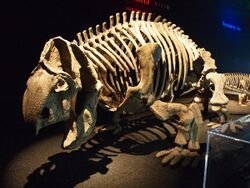
| |
| Mounted skeleton of Ischigualastia jenseni | |
| Scientific classification | |
| Domain: | Eukaryota |
| Kingdom: | Animalia |
| Phylum: | Chordata |
| Clade: | Synapsida |
| Clade: | Therapsida |
| Suborder: | †Anomodontia |
| Clade: | †Dicynodontia |
| Clade: | †Kannemeyeriiformes |
| Family: | †Stahleckeriidae Cox, 1965 |
| Subgroups | |
| |
Stahleckeriidae is a family of dicynodont therapsids whose fossils are known from the Triassic of North America, South America, Asia and Africa.[2]
Classification
Phylogeny
Below is a cladogram from Szczygielski and Sulej (2023):[3]
| Stahleckeriidae |
| ||||||||||||||||||||||||||||||||||||||||||||||||||||||
Genera
| Genus | Status | Age | Location | Description | Images |
|---|---|---|---|---|---|
| Valid | Norian[4] | United States | |||
| Valid | Norian[5] | United States | |||
| Valid | Carnian | Argentina | 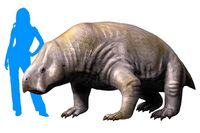
| ||
| Lisowicia | Valid | Late Norian — Early Rhaetian? | Poland | 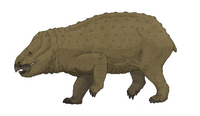 | |
| Valid | Norian[6] | Argentina and Brazil | 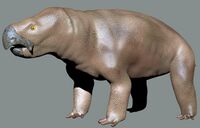 | ||
| Valid | Carnian | Morocco | 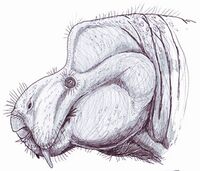
| ||
| Valid | Norian[7] | United States | 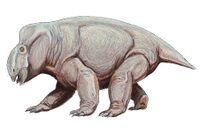
| ||
| Valid | Late Triassic | South Africa | |||
| Valid | Anisian | Zambia | |||
| Valid | Ladinian | Brazil and Namibia | 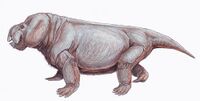
| ||
| Valid | Induan | China |
Initially identified as a stahleckeriid, possibly a more basal genus. |
||
| Valid | Anisian? | South Africa | 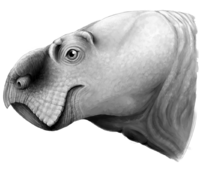
| ||
| Valid | Carnian | Germany and Poland | |||
| Valid | Anisian | Zambia |
References
- ↑ 1.0 1.1 Szczygielski, T.; Sulej, T. (2023). "Woznikella triradiata n. gen., n. sp. – a new kannemeyeriiform dicynodont from the Late Triassic of northern Pangea and the global distribution of Triassic dic ynodonts". Comptes Rendus Palevol 22 (16): 279–406. doi:10.5852/cr-palevol2023v22a16.
- ↑ Kammerer, C. F.; Fröbisch, J. R.; Angielczyk, K. D. (2013). Farke, Andrew A. ed. "On the Validity and Phylogenetic Position of Eubrachiosaurus browni, a Kannemeyeriiform Dicynodont (Anomodontia) from Triassic North America". PLOS ONE 8 (5): e64203. doi:10.1371/journal.pone.0064203. PMID 23741307. Bibcode: 2013PLoSO...864203K.
- ↑ Szczygielski, T.; Sulej, T. (2023). "Woznikella triradiata n. gen., n. sp. – a new kannemeyeriiform dicynodont from the Late Triassic of northern Pangea and the global distribution of Triassic dicynodonts". Comptes Rendus Palevol 22 (16): 279–406. doi:10.5852/cr-palevol2023v22a16. https://sciencepress.mnhn.fr/fr/periodiques/comptes-rendus-palevol/22/16.
- ↑ Mueller, B. D.; Huttenlocker, A. K.; Small, B. J.; Pinto, J. L.; Dean-Wallace, K.; Chatterjee, S. (2023). "A new kannemeyeriiform dicynodont (Synapsida) from a Late Triassic vertebrate assemblage in west Texas, U.S.A.". Journal of Vertebrate Paleontology: e2255236. doi:10.1080/02724634.2023.2255236.
- ↑ Kammerer, C. F.; Fröbisch, J. R.; Angielczyk, K. D. (2013). Farke, Andrew A.. ed. "On the Validity and Phylogenetic Position of Eubrachiosaurus browni, a Kannemeyeriiform Dicynodont (Anomodontia) from Triassic North America". PLOS ONE 8 (5): e64203. doi:10.1371/journal.pone.0064203. PMID 23741307. Bibcode: 2013PLoSO...864203K.
- ↑ Kammerer, C. F.; Ordoñez, M. D. (2021). "Dicynodonts (Therapsida: Anomodontia) of South America". Journal of South American Earth Sciences 108: 103171. doi:10.1016/j.jsames.2021.103171. Bibcode: 2021JSAES.10803171K.
- ↑ Irmis, Randall B.; Mundil, Roland; Martz, Jeffrey W.; Parker, William G. (2011-09-15). "High-resolution U–Pb ages from the Upper Triassic Chinle Formation (New Mexico, USA) support a diachronous rise of dinosaurs" (in en). Earth and Planetary Science Letters 309 (3): 258–267. doi:10.1016/j.epsl.2011.07.015. ISSN 0012-821X. Bibcode: 2011E&PSL.309..258I. https://www.sciencedirect.com/science/article/pii/S0012821X11004316.
Wikidata ☰ Q4526703 entry
 |

